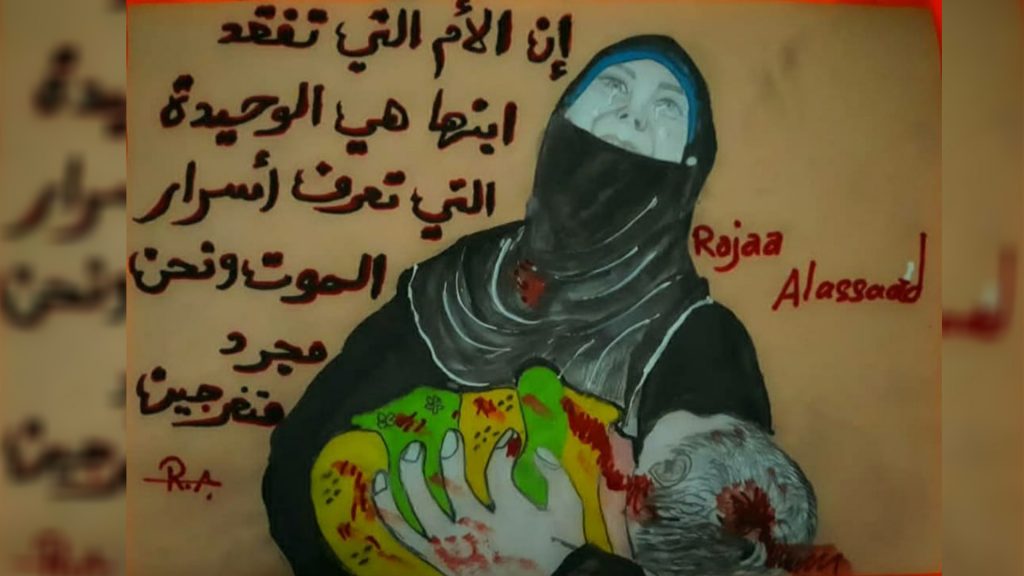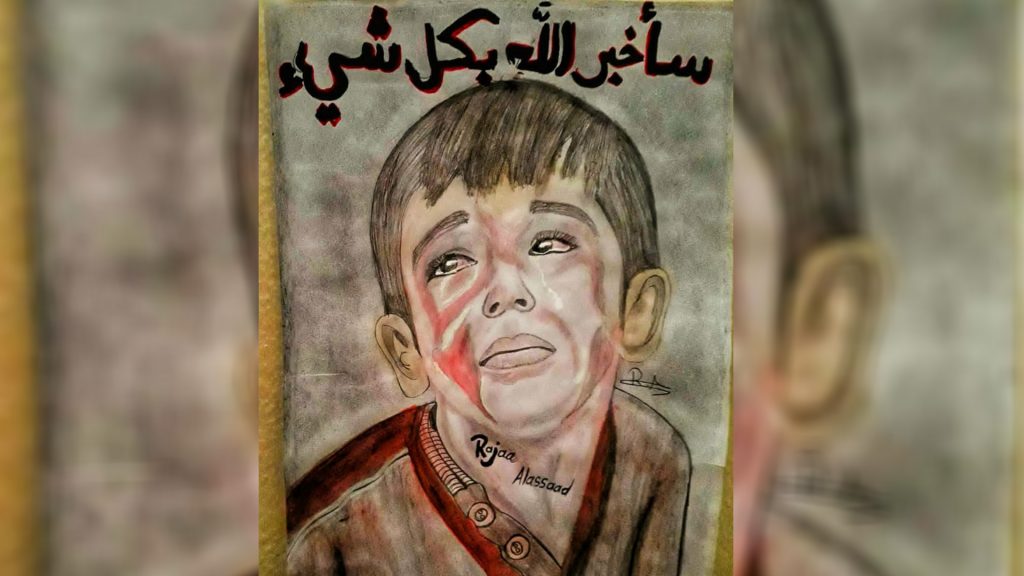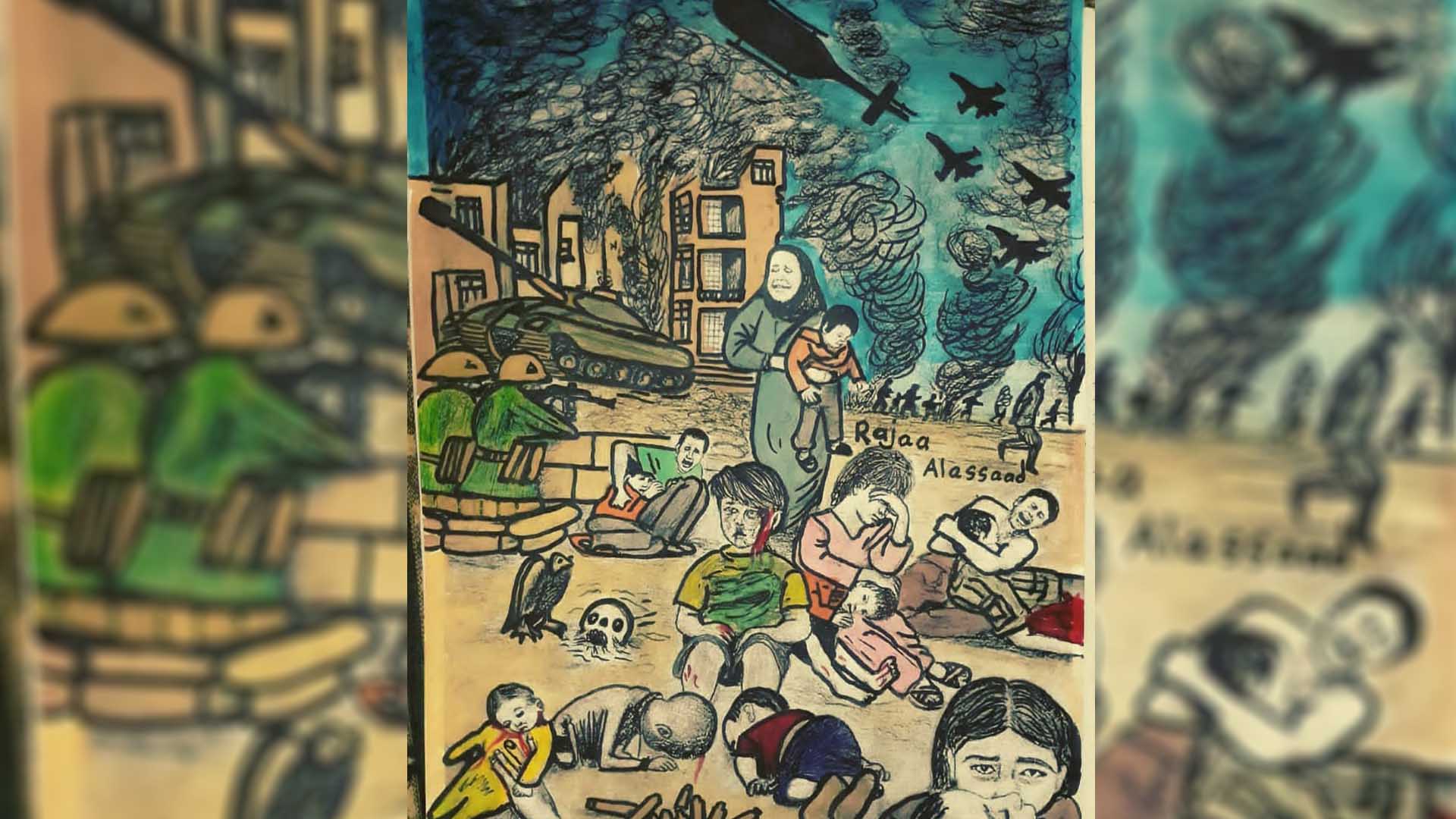IDLIB, Syria (North Press) – With just some small pieces of paper, pens and crayons, Raja’a al-Assad narrates the Syrian war’s tragedies, depicting the brutality of bombing and destruction.
Raja’a, an English teacher from the city of Ma’arat al-Nu’man in the southern countryside of Idlib, was one of the first to join in the peaceful demonstrations in her city at the beginning of the crisis. She is known for her love of drawing since her childhood, which can be seen on the walls of her homes and in her notebooks.

Colored with red
Raja’a did not know that she would use her talent to document the destructions of her country and city. Most of her drawings were colored with red – the only color that expresses what is happening in Syria.
Raja began documenting the daily events and focused on drawing the suffering of Syrians. She depicted detainees in prisons, the daily struggle, the difficulties that children face in their educational journey, in addition to the reality of women and the daily challenges they face.
Raja’a says that she wanted to participate in the popular uprisings since the beginning of their spread in 2011. The idea of drawing was the first thing she thought of, as she could not participate in other ways due to the great security restrictions by the Syrian government intelligence services.
She depicts every event that takes place in Syria, such as massacres, forced displacement, and the regime’s destruction policy to control the areas outside of its grasp.
She draws on paper instead of canvas, because paper is cheaper, and due to her poor living conditions.
Raja’a works as an English teacher in addition to working with several relief teams in northern Syria. She began to expand her activities after the Damascus government lost control of her city, which allowed her to participate in various fields.
“For me, drawing is a talent and a hobby. My family encouraged and supported me. During my childhood my paintings were limited to landscapes, but the events and war that we suffered and lived through motivated me to continue.”
Starting my own exhibition
What helped Raja’a master painting the most was teaching, as she worked on drawing educational aids for students to easily convey information, in addition to watching drawing courses via the Internet, such as those on shading and how to draw faces.
Raja’a hangs her drawings on the wall of her modest room, which represents the popular movement, especially as she has been impacted by the tragedy of Syrian war.
Through drawing, Raja’a expresses her feelings, thoughts, and hopes, for her drawing is the only way to relax. “I never get bored with drawing; drawing is the only way to express my thoughts and opinions. My life has become more fun after mastering drawing.”
Raja’a has participated in several exhibitions, the most important of which was her participation in al-Kindi exhibition in the city of Ma’arat al-Nu’man. Now she is seeking to fulfill her dream of starting her own exhibition in northern Syria, and she hopes that her art will become popular in order to convey her messages to the whole world.

Depicting social norms
Raja’a’s drawings were not limited to documenting destruction and displacement. Through them, she also addressed the challenge of social restrictions and shed light on the living issues and social norms in her region.
In one of her drawings, a veiled woman cries due to the stereotypical vision of society in her region regarding women participating in various life fields. This phenomenon is one of the most prominent obstacles facing women in northern Syria, according to Raja’a.
Like thousands of residents, she was displaced from Ma’arat al-Nu’man after her family’s home was destroyed and the regime took control of the city, so she fled to northern Syria.
Her displacement motivated her to pursue art and to express her country’s tragedy.
“Despite ongoing war and the difficulties we go through, we have hope that we will live to fight for our freedom that was stolen by the Syrian regime and its sectarian rule,” she said.

